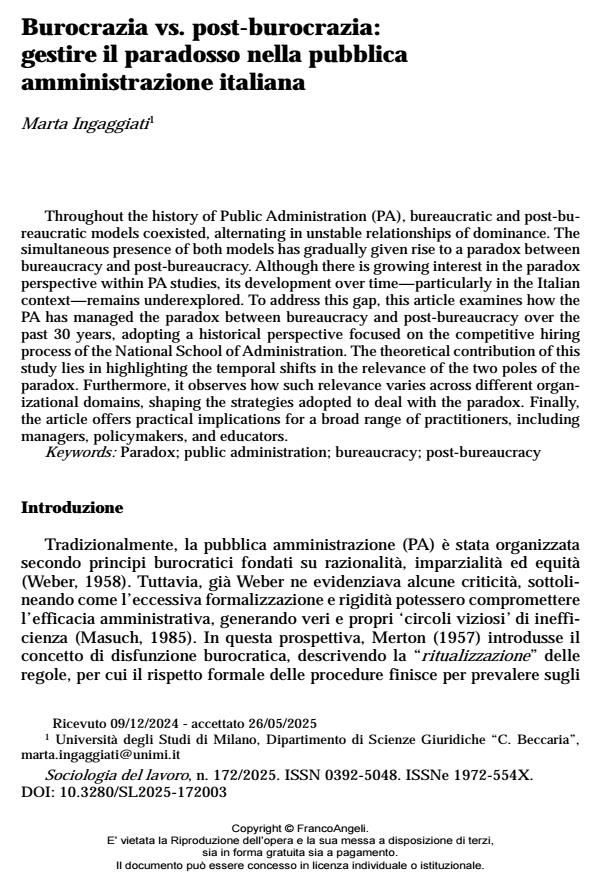Burocrazia vs. post-burocrazia: gestire il paradosso nella pubblica amministrazione italiana
Titolo Rivista SOCIOLOGIA DEL LAVORO
Autori/Curatori Marta Ingaggiati
Anno di pubblicazione 2025 Fascicolo 2025/172
Lingua Italiano Numero pagine 23 P. 50-72 Dimensione file 219 KB
DOI 10.3280/SL2025-172003
Il DOI è il codice a barre della proprietà intellettuale: per saperne di più
clicca qui
Qui sotto puoi vedere in anteprima la prima pagina di questo articolo.
Se questo articolo ti interessa, lo puoi acquistare (e scaricare in formato pdf) seguendo le facili indicazioni per acquistare il download credit. Acquista Download Credits per scaricare questo Articolo in formato PDF

FrancoAngeli è membro della Publishers International Linking Association, Inc (PILA)associazione indipendente e non profit per facilitare (attraverso i servizi tecnologici implementati da CrossRef.org) l’accesso degli studiosi ai contenuti digitali nelle pubblicazioni professionali e scientifiche
Nel corso della storia della Pubblica Amministrazione (PA), i modelli burocratici e post-burocratici hanno spesso convissuto, alternandosi in relazioni instabili di predominanza. La presenza simultanea di elementi appartenenti a entrambi i modelli ha dato origine, nel tempo, a un paradosso tra burocrazia e post-burocrazia. Sebbene negli studi sulla PA vi sia un crescente interesse per la prospettiva paradossale, il suo sviluppo nel tempo e nel contesto italiano rimane ancora poco approfondito. Per colmare questa lacuna, il presente articolo analizza come la PA abbia gestito il paradosso tra burocrazia e post-burocrazia negli ultimi trent'anni, adottando una prospettiva storica incentrata sul corso-concorso della Scuola Nazionale dell’Amministrazione. Il contributo teorico di questo studio consiste nell’evidenziare le variazioni nel tempo della rilevanza dei due poli del paradosso. Inoltre, si osserva come tale rilevanza differisca tra diversi ambiti organizzativi, influenzando le strategie adottate per affrontare il paradosso stesso. Infine, l’articolo propone implicazioni pratiche per un ampio spettro di professionisti, tra cui manager, policymaker e formatori.
Parole chiave:paradosso; pubblica amministrazione; burocrazia; post-burocrazia
Marta Ingaggiati, Burocrazia vs. post-burocrazia: gestire il paradosso nella pubblica amministrazione italiana in "SOCIOLOGIA DEL LAVORO " 172/2025, pp 50-72, DOI: 10.3280/SL2025-172003